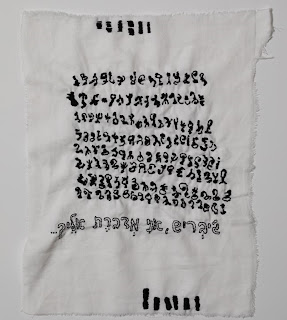ג'יבריש אני מדברת אליך בתיה שני, עבודות רקמה
צהרים טובים
ג'יבריש אני מדברת אליך
בתיה
שני, עבודות רקמה
"וְהִיא שָׁם שׂוֹרֶרֶת בְּקוֹלָהּ הֶעָרֵב,
עוֹשָׂה בְּמַטְוֶה שֶׁל-זָהָב, עֲסוּקָה עַל-נוּל הָאֲרִיגָה"
הומרוס,
אודיסיאה, בתרגום שאול טשרניחובסקי, פרק 5 שורה 30
"השפה הקלסית קרובה הרבה יותר משאנו סבורים
למחשבה שמוטל עליה לבטאה; אך אין היא מקבילה לה; היא אחוזה ברשתה וארוגה במארג
עצמו שהיא פורשת. לא תוצר חיצוני של המחשבה אלא המחשבה עצמה".
מישל
פוקו, המילים והדברים, בתרגום אבנר להב, פרק רביעי
הקשר בין המילים, השפה, הפיוט והשירה למלאכת
האריגה, הרקמה והתפירה, הוא עתיק יומין. מלאכת האריגה הוקבלה עוד על ידי משוררים
בעולם הקלאסי למלאכת מארג המילים של המשורר. הקשר זה עולה באופן מקורי מעבודות
הרקמה של בתיה שני, ובמיוחד מדימוי מעוגל השב ונשנה, שמסביבו רקמת רשת. דימויים
אלו מעלים בזיכרון את התאים והרקמות של צורת המוח האנושי, ולעיתים אף שלובות בהם
כתובות, כמעין מחשבות הצצות ועולות. הרקמה האנושית או רקמת המחשבה הופכת לרקמת
חוטים, וכך המשל והנמשל חד הם. המטאפורה לרקמה אנושית באה לידי ביטוי גם במצע
הרקמה עליו בוחרת שני לרקום. מצע זה הוא
סדינים ובדי ריפוד ישנים. בדים אלו שימשו אותה ואת משפחתה במשך שנים, ובהם מוטבעים
החיים עצמם – הרצונות, התשוקות, החלומות, ההגשמות, הניסיונות, האכזבות, הפציעות,
ימי החולי, ימי האבל, ימי השמחה, האושר, העצב, והמחשבות.
המחשבות הנרקמות כמילים הופכות בחלק מהעבודות
למספרים, כאילו אין המילים מספיקות בכדי לבטא את המחשבות הנרקמות. בעבודות אחרות
ויתרה שני לגמרי על האותיות והמספרים, בעוד הדימויים מופשטים לגמרי. מעשה הרקמה
יהיה כעת ביטוי של המחשבה החופשית, המחשבה לעצמה, שאינה תלויה במילה הכתובה. לעיתים
מקור הדימויים המופשטים נדמה כצמחי או ימי, ועל כן ניתן להגדירם כסימולקרה, כלומר דימוי
או סימן שנדמה כמוכר ושמשתייך לעולם המציאות, אולם מקורו אבד. סימן זה לא ניתן
לקרוא באמצעות השפה המוכרת, כך שנוצרת מעין שפה חדשה, שפת המחשבה של האמנית, שהיא
שפה מקורית וחד פעמית, אשר עבור המתבונן היא למעשה שפת ג'יבריש, כלומר, רצף של הברות חסרות פשר וחסרות משמעות. הרקמה עבורה, מציינת שני, היא
כתפילה, אשר נועדה בכדי לבטא את מחשבותיה ורגשותיה, והיא זו בלבד ההולמת לצורך
ביטוי זה. בעולמה הפנימי עוסקת שני במהות השפה ורקמת המחשבה, וכך יצירתה היא למעשה
יצירה ארס-פואטית, כלומר, יצירה השואלת שאלות לגבי מעשה היצירה עצמו. באופן זה,
השפה הנדמית כחסרת משמעות- ג'יבריש - היא למעשה בעלת משמעות עמוקה, שכן היא השפה
הבלעדית לביטוי שאלות אלו. בתיה שני יוצרת אם כן במעשה הרקמה דבר והיפוכו – הקניית
משמעות עמוקה להברות חסרות משמעות לכאורה, לשפת ג'יבריש סתומה, אשר הופכת
למשמעותית מעין כמותה.
נאוה סביליה שדה
I speak Gibberish
to You
Batia Shani, Needlepoint Works
"As for herself, she was busy at her loom, shooting
her golden shuttle through the warp and singing beautifully."
Homer-The Odyssey, book 5 Unspecified translation
“The classical language
is much closer than we think to the thought it intends to express, but not
parallel. It is captured by its net, woven into the fabric it lays out, not an
external product of thought but thought itself."
Michel Foucault, the order of things, chap. 4
The connection of words, language, liturgical singing, and
poetry with the crafts of weaving, needlepoint, and sewing is ancient.
Classical era poets had compared weaving to the poet’s art of stringing words
together. This context is evident in an original manner in the needlepoint
works by Batia Shani, particularly in a repeating rounded image surrounded by
netting embroidery. These images recall the cells and tissue of the human
brain. Often there is writing embedded in them, like thoughts bubbling up. This
human tissue, or thought tissue, becomes an embroidery so that the analogy
becomes one and the same. The human tissue simile is manifested in the
substrate Shani selects for her embroidery: old sheets and upholstery textiles.
Her family had used these for years, and they have been imprinted with life
itself – the wishes, desires, dreams, fulfillments, experimentations,
disappointments, injuries, days of sickness, mourning, joy, happiness, sadness,
and thoughts.
In some works, the thoughts forming as words turn into
numbers as if the words do not express them sufficiently. Shani has skipped
words and numbers in other works, while the images are entirely abstract. The
needlepoint is now an expression of free thought, independent of the written
word. At times the origin of the abstract images seems to be vegetal or marine,
and so they may be defined as simulacra, an image or a sign that appears familiar,
belonging to reality, but its source has been lost. This sign may not be read
through the known language, so a new language is born, the language of the
artist’s thoughts. It is original and unique, while for the viewer, it is
Gibberish – a sequence of meaningless syllables. Needlepoint, says Shani, is
for her like prayer, intended to express her thoughts and emotions, being the
only one fitting this need for expression. In her internal world, Shani
addresses the essence of language and the embroidery of thought. Her work is
thus ars-poetical, asking questions about the very act of creation. In this
way, the meaningless-seeming language – Gibberish – has, in fact, profound
meaning, being the singular one capable of expressing these questions. Batia
Shani creates contradictions in her embroidery – bestowing profound meaning
onto apparently meaningless syllables, and obtuse Gibberish language, which
becomes uniquely meaningful.
Nava Sevilla Sade

.jpg)
%20(1).jpg)
.jpg)


.png)


תגובות
הוסף רשומת תגובה